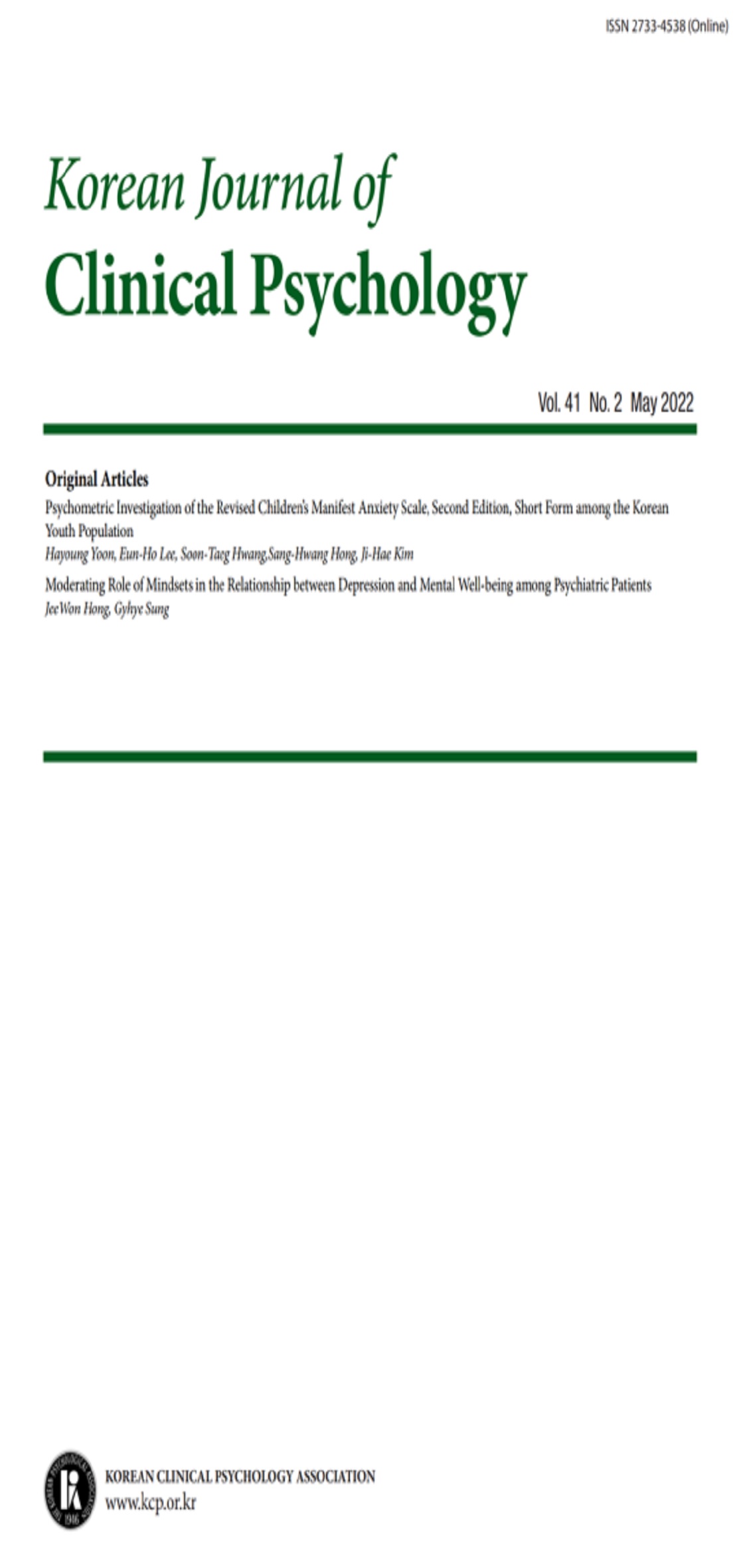open access
메뉴
open access
메뉴 E-ISSN : 2733-4538
E-ISSN : 2733-4538
본 연구에서는 일반 집단과 가정 폭력으로 의뢰된 임상 집단을 대상으로 우리나라 가정 폭력의 발생 비율과 유형, 심각성 및 가정 폭력에 대한 지각과 태도에 대해 알아보았다. 또한 가정 폭력이 피해자들의 심리적인 적응 및 자녀 양육 태도와 학대에 미치는 영향에 대해서도 살펴보았다. 일반 집단은 서울의 강남과 강북, 인천, 일산, 대전, 충주, 광주, 대구, 부산에 거주하는 한 명 이상의 자녀를 둔 721명의 주부들로 구성되었으며, 임상 집단은 가정 폭력으로 의뢰된 가정 폭력 피해자 13명이었다. 이들을 대상으로 생활 경험 조사 질문지와 대처 방식 척도, 갈등 대처 유형 척도(CTS-2), 그리고 양육 태도에 대한 질문지 및 아동 학대 평가 척도를 실시하였으며, 임상 집단의 경우에는 CBCL과 SCL-90-R도 함께 실시하였다. 그 결과 일반 집단의 경우, 192명(26.6%)이 가정 폭력을 경험한 것으로 나타났으며, 151명(81.6%)이 언어 폭력을, 53명(27.9%)이 심리적 폭력을, 39명(20.9%)은 성폭력을, 36명(19.1%)은 신체적 폭력을 경험했다고 보고하였다. 또한 일반 집단의 경우에는 결혼 2-3년 후부터 폭력을 당하기 시작한 사람이 51.6%로 가장 많았으나 임상 집단은 결혼 초부터인 경우가 많았다. 더욱이 가정 폭력 경험이 있는 일반 집단의 경우에는 가정 폭력이 없는 집단들에 비해 배우자의 폭력 행동을 자신에 대한 관심이나 사랑의 표현이며, 그럴 수도 있다고 지각하는 비율이 높았다. 임상 집단과 가정 폭력을 경험한 일반 집단을 비교한 결과, 일반 집단이 자녀에 대해 더욱 통제적이고 일관적인 양육 태도를 취하였다. 그러나 임상 집단이 자녀를 학대할 가능성이 유의미하게 높았으며, 자녀에게 신체적 학대 및 방임을 더 행하고 있는 것으로 나타났다.
The purpose of this study was to explore the rate, type, and severity of spouse abuse, and the attitude and perception of victimized wives regarding to domestic violence. In addition, we examined the effect of domestic violence on abused partner's functioning and parenting behavior as well as their potentiality of child abuse. Subjects consisted of 721 married women in community and 13 victimized wives referred by police or court. Clinical psychologists who were trained in clinical interview and psycho-diagnostic tests collected data from the subjects using a structured clinical interview and questionnaires. Self-report questionnaires, including Negative Life event Questionnaire, Coping Strategy Questionnaire, CTS-2, Parenting Behavior Inventory and a Scale for Attitude and Perception about domestic violence were used. In community group, wives who have experienced domestic violence were 192(26.6%). Among them, the percentage of physical abuse was 19.1%, verbal abuse 81.6%, emotional abuse 27.9% and sexual abuse 20.9%. Women with abused history in community group perceived their husband's violent behaviors as an expression of concern, and as more changeable than women without abused history. Furthermore, abused women in community group reported that domestic violence could be understandable, while non-abused women reporting it would be absolutely unacceptable. Abused women in community group as well as clinical group were found to have more severe life stress compared to non-abused women. Abused women in community group showed more controlling and consistent attitude toward their children. But, victimized wives in clinical group showed higher potentiality of child abuse due to problems in spousal relationship than abused women in community group. And also they show more physical and emotional abuse as well as neglect to their child.
(1984) 간이 정신 진단 검사, 중앙적성문화사
(1988) 부부 폭력의 임상 실제,
(1985) 스트레스 대처방식의 구성요인 및 우울과의 관계 고려대학교 행동과학 연구소 행동과학연구,
(1998) 한국 가정의 폭력 실태와 사회복지 개입의 필요성 부부폭력을 중심으로,
(1997) 갈등 대처 유형척도의 한국부부에 대한 타당성 연구 남편의 갈등대처 유형 및 아내학대 행위를 중심으로,
(2000) 가정 폭력이 아동의 자아존중감에 미치는 영향,
(1993) 사건귀인 및 무망감과 우울의 관계 공변량 구조모형을 통한 분석,
(1997) 아동청소년 행동 평가 척도, 중앙적성 출판사
(2001) 집단 프로그램을 통한 가정 폭력 피해 여성의 심리적 증후 변화에 관한 사례 연구,
(1999) 부부 폭력 피해 여성의 경험에 관한 문화기술적 연구,
(2001) 가정 폭력 경험자녀의 적응을 위한 사회복지 실천 개입 방안에 관한 연구,
(1998) 아동학대 평가 척도 개발,
(2003) 가정 폭력의 실태와 대책에 대한 연구,
(2000) 아내구타에 대한 경찰의 태도 및 개입방법에 관한 연구,
(1983) Manual for the child behavior checklist and revised child behavior profile University of vermont Department of psychiatry,
(2001) The direct and indirect effects of domestic violence on young childrens's intellectual functioning,
(1988) Developmental outcomes in physically abused children Consequences of parental abuse or the effects of a more general breakdown in caregiving behaviors,
(1993) Violence against women by male partners,
(1984) Naturalistic observations in the home setting Journal of Abnormal Psychololgy,
(1991) Prevention of wife battering insights from cultural analysis,
(1984) Children's observations of interparental violence,
(1993) School performance and disciplinary problems among abused and neglected children,
(1985) Study of emotion and coping during three stages of a college examination Journal of Personality and Social Psychology,
(1979) Violence in the American family Journal of Social Issue,
(1998) Social functioning of preschool-age children whose mothers are emotionally and physically abused,
(1991) Evidence from battered women,
(1990) Children of battered women,
(1985) Critical issues in the assessment of children's adjustment to witnessing family violence,
(1995) Social network and family violence in cross-cultural perspective,
(1999) Parenting in battered women: The effects of domestic violence on women and their children, Manuscript submitted for publication
(1997) Children's exposure to marital aggression: Direct and mediated effects,
(1994) Psychological abuse between adult partner Handbook of Developmental Family Psychology and Psychopathology, INC
(1993) Relationship of trauma severity to trauma symptoms for child witnesses Paper presented at the meeting of the american psychological association,
(1978) Assessing the impact of life changes Development of the life experiences survey Journal of consulting and clinical psychology,
(1959) A circumlex model for maternal behavior Journal of Abnormal and social psychology,
(1996) Societal change and change in family violence from 1975 to 1985 as revealed by two national survey,
(1985) Children of battered women the relation of child behavior to family violence and maternal stress Journal of Consult and Clinical Psychology,
